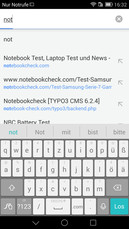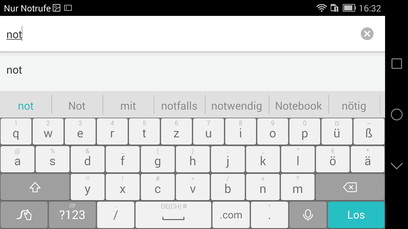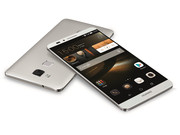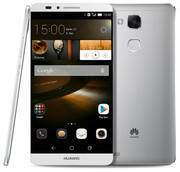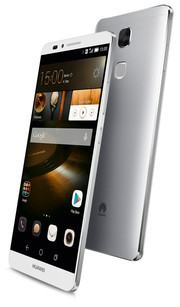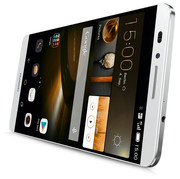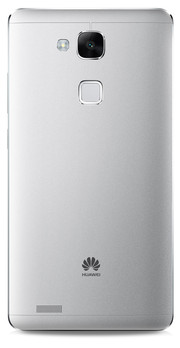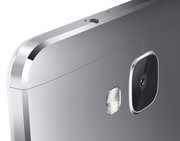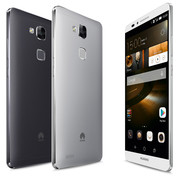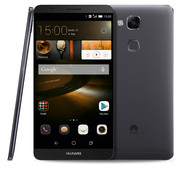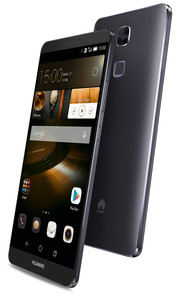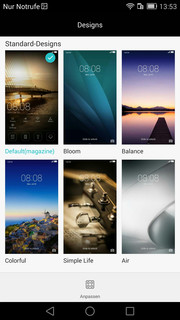Huawei Ascend Mate 7 Phablet Review

For the original German review, see here.
Our Huawei Ascend Mate 7 could certainly be seen as a response of the fast-growing Chinese manufacturer to Apple's iPhone 6 Plus plagued by "bendgate" and software issues. 6-inch phablets can normally be carried around easily in a pocket but not be used with only one hand. However, multimedia content is more enjoyable on larger screens, and the bigger on-screen keyboard facilitates writing. Huawei again relies on a Kirin SoC, which is currently one of the fastest of its kind, unlike the integrated Mali graphics. The IPS screen has a resolution of 1920x1080 pixels. The somewhat unusual design of the very well-conceived user interface dubbed Emotion UI 3.0 could also be an attempt to close in on the iPhones' elegant appearance. In addition to the iPhone 6 Plus, we picked current smartphones with a size and performance similar to that of our review sample for our benchmark comparisons. The challengers are: LG G Flex, Samsung Galaxy Note 3 SM-N9005, and the brand new Motorola Moto X 2014.
Case
The back and the edges of Huawei's silver Ascend Mate 7 are primarily made of shimmering, matte aluminum. The material also largely repels fingerprints, and it makes a high-quality and solid impression. The fact that the device can barely be warped matches that. One would have to be very nit-picky to call the existing, minute irregularities production flaws. The narrow bezel points to a great screen-to-body ratio, which reinforces the impression. The smartphone is nice to hold owing to its rounded corners and the lack of sharp edges. However, using it with only one hand will likely only be possible if your name is Dirk Nowitzki. The Mate 7 is relatively light for a metal smartphone of this size.
Connectivity
There is nothing special to say about the interfaces. The power button and volume rocker are on the right, the headphone is connected on the upper edge, the micro-USB port, SIM and SD slots are on the upper left. A fingerprint sensor, which can be used for unlocking the screen, is on the back. That functioned impeccably in the test.
Software
Huawei has put a lot of effort into designing the stylish Emotion UI 3.0. There are some free design themes to choose from, and which include nicely adapted, color-matched icons for many preloaded apps. Compared with other manufacturer UIs, it is immediately noticed that there is no app drawer just like in the older versions of Huawei's user interface. The device relies on home-screen folders like "Tools" or "Google" instead. Notifications are displayed in a timeline. The user can specify whether and how every single app can access the Internet in the feature-rich phone manager. In addition to other tools, a storage cleaner, harassment filter, and notification manager are also found here. They allow controlling the torrent of Android typical notifications comfortably. The manufacturer basically only installs useful, visually adapted stock apps, such as calendar, contacts, recorder, gallery, music, etc., alongside Asphalt 8 and Polaris Office 4.0. Recently installed apps are illuminated - practical.
Communication & GPS
The Wi-Fi module supports the IEEE 802.11 a/b/g/n standards and transmits in both the 2.4 GHz band and the less frequented 5 GHz band. It incorporates Bluetooth 4.0 and BLE. A satellite was found within seconds via GPS in a room with a big window. It also remained stable for a much longer time even when increasing the distance to the roof, exterior walls and windows than in other GPS-capable devices that the author has tested under the same circumstances to date. In total, the GPS proved to be accurate and highly responsive.
Telephony & Voice Quality
The phone app only has few additional features worth mentioning, such as a pocket mode and SIP manager for Internet telephony, which merge seamlessly into the overall design. The author called a landline number from the German D1 net for the test. The contact's voice was very intelligible and sounded warm and natural. Although the caller's voice was absolutely intelligible, it was also a bit muffled and hollow.
Cameras & Multimedia
The primary camera's resolution of 13 MP is impressive. The backlit BSI sensor promises a better yield of light. However, it cannot prevent image noise indoors, although it is moderate compared with other smartphone cameras. The camera shoots good pictures for a smartphone unit in daylight. Huawei has managed to unite image sharpness, detail richness, and noise cancelling fairly well. Exposure is a bit short, but some pictures have a light HDR touch to them owing to a subtle brightening of shadows. Low-contrast textures like the twigs of a leafless tree look muddy in particular at the picture's edges. We very much liked the rather natural color reproduction and decent exposure range that prevents faded lights. The camera app provides some extras like photo effects and a Best Picture mode. Good news not only for selfie fans: The image quality of the 5 MP webcam sticks out positively from most of its counterparts.
Accessories
Not even a power supply was included for our review sample. However, the device's page states that one is normally part of the delivery, alongside a USB cable, stereo headphones and quick-start guide.
Warranty
We did not find any device specific information, but a two-year warranty is the rule for Huawei.
Input Devices & Controls
The clearly arranged keyboard does not have anything special to offer apart from a swype feature. Huawei does not implement a number row. As usual, word suggestions are faded in at the top. Owing to the accurate and responsive touchscreen as well as enough surface area, it was possible to use the keyboard confidently and quite speedily. However, we have make deductions here because the feature for single-handed operation, which is to move the keyboard and navigation bar closer to the thumb, completely denied work.
Display
16:9 is again the aspect ratio of choice. In our opinion, the Full HD resolution (367 ppi) of the razor-sharp IPS screen utilizes the six inches perfectly. Higher pixel densities only look better on paper, even if the marketing strategies created by the manufacturers want to suggest something else. Despite the good illumination of 93%, our review sample exhibited subtle halos at its edges in dark content. The maximum brightness is well above average compared with other, modern smartphones, but it is not top. A superb contrast of 980:1 results in conjunction with the very good black level of 0.46 cd/m². For comparison, the iPhone 6 has a slightly higher brightness, but its black level of 0.62 cd/m² "only" leads to a contrast of 837:1.
| |||||||||||||||||||||||||
Brightness Distribution: 93 %
Center on Battery: 451 cd/m²
Contrast: 980:1 (Black: 0.46 cd/m²)
ΔE Color 2.49 | 0.5-29.43 Ø5
ΔE Greyscale 2.88 | 0.57-98 Ø5.3
| Huawei Ascend Mate 7 Mali-T628 MP6, Kirin 925, 16 GB eMMC Flash | LG G Flex Adreno 330, 800 MSM8974, 32 GB eMMC Flash | Apple iPhone 6 Plus PowerVR GX6450, A8, 64 GB eMMC Flash | Samsung Galaxy Note 3 SM-N9005 Adreno 330, 800 MSM8974, 32 GB SSD | Motorola Moto X 2. Gen 2014 Adreno 330, 801 MSM8974AC, 16 GB eMMC Flash | |
|---|---|---|---|---|---|
| Screen | -51% | -15% | 4% | -51% | |
| Brightness middle | 451 | 309 -31% | 519 15% | 335 -26% | 259 -43% |
| Brightness | 455 | 311 -32% | 496 9% | 342 -25% | 263 -42% |
| Brightness Distribution | 93 | 96 3% | 90 -3% | 81 -13% | 91 -2% |
| Black Level * | 0.46 | 0.62 -35% | 0.1 78% | ||
| Contrast | 980 | 837 -15% | 3350 242% | ||
| Colorchecker dE 2000 * | 2.49 | 4.96 -99% | 3.67 -47% | 6.14 -147% | 6.52 -162% |
| Greyscale dE 2000 * | 2.88 | 5.69 -98% | 3.78 -31% | 5.27 -83% | 3.05 -6% |
| Gamma | 2.41 91% | 2.42 91% | 2.39 92% | 2.31 95% | |
| CCT | 7985 81% | 7327 89% | 7559 86% | 6226 104% |
* ... smaller is better
DeltaE determines to what extent the reproduced colors deviate from the target. The ascertained rates of less than 3 (Grayscale and ColorChecker) point to an unusually high color accuracy, which can be confirmed subjectively. Not even the iPhone 6 Plus that is very good in this field can compete with that. Assuming a color gamut close to sRGB, the screen should even satisfy demanding, semi-professional photographers.
The maximum brightness can even defy the ambient light on sunny days as long as bright objects are not reflected on the screen.
The Mate 7's colors largely remain true even in very narrow viewing angles. However, moderate brightness losses are noticed quite early when the screen is tilted. IPS is capable of more, as the Asus MeMO Pad 7 proves. But that is complaining on a very high level.
Performance
The HiSilicon Kirin 925 is an ARM-based octa-core SoC with two CPU clusters. One cluster is comprised of four energy-efficient A7 cores that clock with up to 1.3 GHz, and the other of four faster A15 cores that are enabled in demanding computations and can achieve up to 1.8 GHz (big.LITTLE design). The benchmark chart and the comparison with other current premium smartphones in our database show that the processor's performance belongs in the high-end sector, particularly in multi-threading, and that it can even compete with the lightning-fast A8 dual-core in the iPhones from 2014. Its single-core performance is not as good. Like in most modern smartphones from Huawei, AndroBench 3 used for assessing the storage performance does not record any pleasing results. Though the sequential read performance can just still be called clearly below average, the achieved 7.32 MB/s in the random read 4K test belongs to the lower end of comparable devices.
| Geekbench 3 | |
| 32 Bit Multi-Core Score (sort by value) | |
| Huawei Ascend Mate 7 | |
| LG G Flex | |
| Apple iPhone 6 Plus | |
| Motorola Moto X 2. Gen 2014 | |
| 32 Bit Single-Core Score (sort by value) | |
| Huawei Ascend Mate 7 | |
| LG G Flex | |
| Apple iPhone 6 Plus | |
| Motorola Moto X 2. Gen 2014 | |
| 3DMark | |
| 1280x720 offscreen Ice Storm Unlimited Physics (sort by value) | |
| Huawei Ascend Mate 7 | |
| LG G Flex | |
| Apple iPhone 6 Plus | |
| Motorola Moto X 2. Gen 2014 | |
| 1280x720 offscreen Ice Storm Unlimited Graphics Score (sort by value) | |
| Huawei Ascend Mate 7 | |
| LG G Flex | |
| Apple iPhone 6 Plus | |
| Motorola Moto X 2. Gen 2014 | |
| 1280x720 offscreen Ice Storm Unlimited Score (sort by value) | |
| Huawei Ascend Mate 7 | |
| LG G Flex | |
| Apple iPhone 6 Plus | |
| Motorola Moto X 2. Gen 2014 | |
| AndroBench 3-5 | |
| Random Write 4KB (sort by value) | |
| Huawei Ascend Mate 7 | |
| LG G Flex | |
| Motorola Moto X 2. Gen 2014 | |
| Random Read 4KB (sort by value) | |
| Huawei Ascend Mate 7 | |
| LG G Flex | |
| Motorola Moto X 2. Gen 2014 | |
| Sequential Write 256KB (sort by value) | |
| Huawei Ascend Mate 7 | |
| LG G Flex | |
| Motorola Moto X 2. Gen 2014 | |
| Sequential Read 256KB (sort by value) | |
| Huawei Ascend Mate 7 | |
| LG G Flex | |
| Motorola Moto X 2. Gen 2014 | |
| AnTuTu v5 - Total Score (sort by value) | |
| Huawei Ascend Mate 7 | |
| Apple iPhone 6 Plus | |
| Motorola Moto X 2. Gen 2014 | |
The browser benchmark scores once again prove that users who find highest Internet browsing speed important will hardly get around Apple's iPhones. Our review sample exhibited absolutely inconsistent results. It looked very good in Octane v2 (which prefers the used Chrome browser), but SunSpider and Mozilla Kraken place the Mate 7 in the last place of current smartphones. Subjectively, we enjoyed browsing, but we have also seen this somewhat better on other devices.
| Sunspider - 1.0 Total Score (sort by value) | |
| Huawei Ascend Mate 7 | |
| LG G Flex | |
| Apple iPhone 6 Plus | |
| Samsung Galaxy Note 3 SM-N9005 | |
| Motorola Moto X 2. Gen 2014 | |
| Octane V2 - Total Score (sort by value) | |
| Huawei Ascend Mate 7 | |
| LG G Flex | |
| Apple iPhone 6 Plus | |
| Motorola Moto X 2. Gen 2014 | |
| Mozilla Kraken 1.1 - Total (sort by value) | |
| Huawei Ascend Mate 7 | |
| LG G Flex | |
| Apple iPhone 6 Plus | |
| Samsung Galaxy Note 3 SM-N9005 | |
| Motorola Moto X 2. Gen 2014 | |
* ... smaller is better
Games
The integrated graphics solution dubbed Mali-T628 MP6 is now more found in the upper range. It is, however, still strong enough to render even demanding games smoothly. In any case, it incorporates features like OpenGL ES 3.0, OpenCL 1.1, and DirectX 11, making it reliable for the foreseeable future. Overall, the GPU can almost compete with the widespread Adreno 330 (Qualcomm Snapdragon 800 / 801). However, 3DMark records an advantage of as much as 22 to 44% for this chip in the LG G Flex and Motorola Moto X 2014 over the Mali graphics. The still beautiful Asphalt 7 ran absolutely lag-free, and we did not have any problems with the controls using the position sensor.
Emissions
Temperature
The phablet reached a maximum load temperature of 40 °C, which was not a problem for the tester.
(+) The maximum temperature on the upper side is 39.8 °C / 104 F, compared to the average of 35 °C / 95 F, ranging from 21.9 to 56 °C for the class Smartphone.
(+) The bottom heats up to a maximum of 38.4 °C / 101 F, compared to the average of 33.8 °C / 93 F
(+) In idle usage, the average temperature for the upper side is 29.8 °C / 86 F, compared to the device average of 32.7 °C / 91 F.
Speakers
The relatively loud mono speaker did not make a good impression in the test, but it was not annoying either. There was no sign of bass or dynamics, and it completely lacked surround. Voices are well intelligible and present but sometimes sound a bit hoarse. At least the sound is mid-heavy enough that playback never sounded piercing. The tester was not plagued by volume fluctuations either. When placed on a table, the speaker rests on its surface.
Energy Management
Power Consumption
Among the few 6-inch phablets that we tested in the past twelve months, the Mate 7 proved to be the most economical in load, as it would usually only occur in games. The consumption is exactly on average in idle mode (avg).
| Off / Standby | |
| Idle | |
| Load |
|
Battery Runtime
Approximately 11.5 hours in the practical Wi-Fi test is roughly half an hour less than the average runtime of all 6-inch phablets from the past twelve months. LG's G Flex is particularly good in this exercise. The aforementioned phone manager also provides the user with different, cleverly implemented energy-saving options. For example, it is possible to display especially power-devouring applications with a close function in the notification field, and to determine which apps are to be automatically closed in standby.
Verdict
In total, Huawei's iPhone rival made a very good impression in the test. Apart from the graphics unit that we "only" see in the upper range, it provides premium-range performance. The minor weaknesses that we could measure are more theoretical. Multimedia friends will be satisfied with the good, big screen and the more than just useful camera. However, they will have to accept the poor sound. We found the Emotion UI 3.0 functionality good and its looks very attractive. The phone manager bursts with useful features that are a real added value and are a unique selling point of Huawei's new smartphones.
The elegant and solid casing of the Ascend Mate 7 does not need to fear comparison with contenders from Apple. The screen-to-body ratio should even be superior to the iPhone 6 Plus (although it is thinner). The fingerprint sensor can be listed as a striking feature. GPS is available everywhere, but rarely with such a good reception performance. Objectively, our Huawei Ascend is technically almost equal to and otherwise fully on par with the Apple rivals, but the iPhone 6 Plus with the same storage capacity costs 60% more. However, experience shows that regular Apple customers will not be open for these factual arguments. Buyers who can adapt to the size and to Android receive a clear purchase recommendation from us. This much phablet for this price is not found everywhere.


 Deutsch
Deutsch English
English Español
Español Français
Français Italiano
Italiano Nederlands
Nederlands Polski
Polski Português
Português Русский
Русский Türkçe
Türkçe Svenska
Svenska Chinese
Chinese Magyar
Magyar






